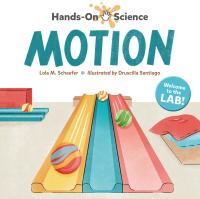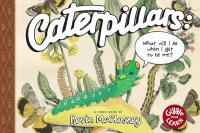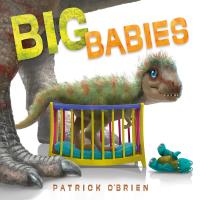
Physics can be fun, and just as important, its principles are seen in everyday activities. Straightforward language complemented by basic illustrations present information and encourage experimentation.
Hands-On Science: Motion

Science continually evolves as new information is uncovered — literally, in the case of fossilized dinosaurs. Accessible, digestible, and engaging information is presented in an oversized, generously illustrated format.
Everything You Know About Dinosaurs Is Wrong!

A group of boys in Thailand wanted to play soccer but where could they practice? Their village was surrounded by water, so they had no field. Inspired by the real boys of Koh Panyee, a floating playing field was built. Realistic illustrations evoke the village and its tenacious young residents.
Building a Dream: How the Boys of Koh Panyee Became Champions

The moving story of the Anishinaabe woman who became louder when water — the source of life — was being ignored, is revealed in lyrical language and bold illustrations. A forward by Autumn Peltier, begins this powerful plea for continued action.
Autumn Peltier, Water Warrior

Ever wonder how a teenager named Peter Parker became a superhero? It started in the imagination of a comic aficionado named Steve Ditko who changed the perception of how a superhero should look. A brief but lively look at the man and his creation of the Marvel hero is presented in staccato language and comic book style art.
Along Came a Radioactive Spider

On its long migration to Antarctica, an Arctic tern sees whales, geese, and more on its journey. Luminous illustrations show what the tern sees from above sometimes in panels, sometimes on full-page spreads. Backmatter provides a bit of information about the animals seen on the tern’s journey.
Time to Move South for Winter

A young scientist explains to a caterpillar what it will be when it grows out of this stage of its life. With clear illustrations, accessible language, and lots of humor, science comes to life in the hands of the creator who wrote the informative and equally engaging The Real Poop on Pigeons and Snails Are Just My Speed.
Caterpillars: What Will I Be When I Get to Be Me?

Brief information is placed on open pages with lots of white space to highlight portraits of baby dinosaurs that are seriously cute and seriously funny. The baby T-rex — “tyrant lizard king“ — is placed in a bejeweled royal crown, with a partial view of a huge parent looking down at the fuzzy baby. Additional information and comparative size chart conclude this informative, amusing book.
Big Babies

Folk art and crisp language introduce the human heart to readers (along with some interesting tidbits about other creatures’ hearts). Accessibly written by a pediatric cardiologist, this handsome book can be read from cover to cover or dipped in and out of.
All About the Heart

One side of the accordion folds out to show a range of human faces (plus one canine). Infants can see familiar toys and objects on the other side of the foldout. Sturdy pages and bright, simple illustrations are just right for the youngest to examine again and again.
Look: A Tummy Time Book

Around the world, grandparents and grandchildren share everyday activities but most important of all, they share lots of love. Warm families are depicted in each color photograph in the latest addition of the Global Babies series.
Global Baby Grandparents

Following each rhyming clues is the animal that inspired various inventions such as snowshoes and water fins. More familiar inventions are followed by lift-the-flaps to intrigue or confound more sophisticated readers.
Copy That, Copy Cat! Inventions Inspired by Animals

From purple lupines in Olympia (Washington) to pink “bleeding tooth fungus” in Maine’s Acadia National Park there are other vivid colors from nature that can be found in ten of the nation’s most visited national parks.
Colors of the National Parks

Budding backyard scientists can start exploring their world with this stunning introduction to these flowery show-stoppers — from seeds to roots to blooms. Learning how flowers grow gives kids beautiful building blocks of science and inquiry.
What’s Inside a Flower?

Meet seeds that pop, hop, creep, and explode in this vividly illustrated introduction to the simplest concepts of botany. Learn about the many ways that seeds get from here to there, engaging children’s curiosity with strong action verbs. Clear photographs with fact-packed captions provide supporting details, explaining the role of seed features and functions in creating new generations of plants. Concludes with an illustrated glossary and back matter featuring more resources.
A Seed Is the Start

How many people actually know where chocolate comes from? How it’s made? Or that monkeys do their part to help this delicious sweet exist? Kids will learn that chocolate comes from cocoa beans, which grow on cocoa trees in tropical rain forests. But those trees couldn’t survive without the help of a menagerie of rain forest critters: a pollen-sucking midge, an aphid-munching anole lizard, brain-eating coffin fly maggots — they all pitch in to help the cocoa tree survive. Two wise-cracking bookworms appear on every page, adding humor and further commentary, making this book accessible to readers of different ages and reading levels.
No Monkeys, No Chocolate

In Manu National Park in Peru, an amazing fourteen different species of monkeys live together. That’s more than in any other rainforest in the world! How can they coexist so well? Find out in this lyrical, rhyming picture book that explores each monkey’s habits, diet, and home, illustrating how this delicate ecosystem and its creatures live together in harmony. From howler monkeys to spider monkeys to night monkeys, young readers will love getting to know these incredible primates and seeing the amazing ways they share their forest.
Fourteen Monkeys

With the soothing rhythm of a bedtime story and the scientific wonder of a nature documentary, comes a celebration of the moon and all the creatures who rely on its light to find their way home. Under the glow of a shimmering moon, creatures great and small creep out of their dens, using its light to hunt, fend off predators, build their nests or build families. As the moon changes phases these animals adapt their behavior to match its waxing and waning — while human animals look on in wonder.
Thank You, Moon

On the night of November 20, 1969, eighty-nine young Native American activists crossed the San Francisco Bay under cover of darkness, calling themselves the “Indians of All Tribes.” Their objective? To claim the former prison island of Alcatraz, basing their actions on an 1868 treaty that said abandoned federal land could be returned to Indigenous peoples. Taking a stand on an island reclaimed as “Indian Land,” these peaceful protestors brought worldwide attention to the issues facing present-day Native Americans, as well as the centuries of unjust federal Indian policy.
Of All Tribes: American Indians and Alcatraz

Ever wonder what to do when it’s too rainy, too hot, or you just want to do something different? Ideas abound in this inspiring collection of activities for both indoors and outside. Some will require adult supervision; others are just right without. All are clearly presented in an easy to follow, illustrated format.
365 Days of Play: Activities for Every Day of the Year

Heroes are “curious, critical, and even uncertain in the face of adversity.” This was true of Claudette Colvin who planted a seed that started the Montgomery bus boycott. Her story is told from her point of view juxtaposed to the Rosa Parks, a lifelong activist. Cartoon illustrations and accessible language tell the story of how many people came together to effect change.
Rosa Parks and Claudette Colvin: Civil Rights Heroes

The development of the atomic bomb during World War II first originally presented in the author’s book, Bomb, has been recast in a graphic format. Dramatically illustrated, the story in history comes vividly to life in a fresh and different way.
Bomb

Dip in or start at the beginning to follow the trail to amazing, unique, and always intriguing tidbits of information about a world of animals. Silly and often laughable illustrations open the format for an open and appealing book.
Animal FACTopia! Follow the Trail of 400 Beastly Facts

What is wind? How does it help people and animals? Is there wind in space? These and other intriguing questions are asked then briefly answered on each briskly illustrated double page spread. Though there is no back matter, both author and illustrator thank authoritative sources.
